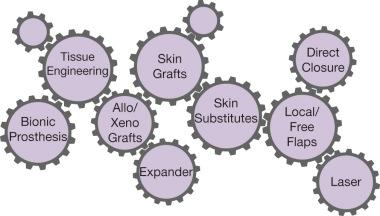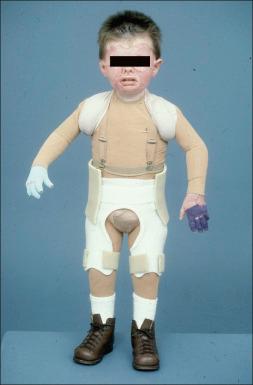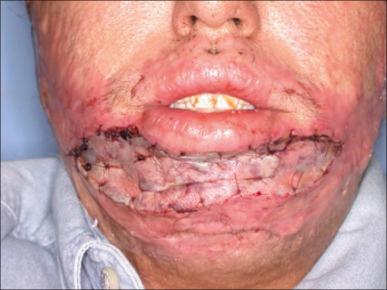Physical Address
304 North Cardinal St.
Dorchester Center, MA 02124
The severity of burn injuries can usually be ascertained if not by patient survival then by the consequences of the injury: scar hyperplasia/hypertrophy, scar contracture, and structural deformities due to loss of bodily components. Since bodily deformity is closely related to the magnitude of injury, restorative procedures are seldom indicated if the depth of injury is superficial and the burned area limited ( Fig. 49.1 ). However, these procedures are required for deep burns ( Fig. 49.2 ).
Formation of scar tissues at a wound site and contraction of those scar tissues are the normal consequences of an injury. At a microscopic level, thickened and contracted scar tissues (i.e., changes that are “normal” and “expected” consequences of the wound-healing processes) appear as collagens arranged in whorls and nodules. These changes can be observed as early as 3–4 weeks following the injury, and they are cosmetically unsightly and disturb function ( Fig. 49.3 ).
Burn injury is a traumatic condition resulting in aberrant physiological processes caused by thermal destruction of the skin. These physiologic alterations affect not only healing of the original burn wounds, but also healing as part of secondary surgical procedures. The treatment should aim to repair the burn wounds first, and attempts to restore deformities should be delayed until recovery from the initial phase of injury is complete. As initially described by Knobloch and Vogt, each surgical approach and reconstructive procedure interacts with another. Hence burn reconstructive surgery can best be viewed as reconstructive clockwork ( Fig. 49.4 ).

Making a decision of how to operate on a patient with burn deformities is quite simple. In contrast, deciding when to operate on a patient with burn deformities can be difficult. Creating a realistic plan to restore physical function and to alleviate pain and discomfort in the area of injury requires an in-depth analysis of the physical deformities and psychological disturbance sustained by the patient. Psychiatric, psychosocial, and physiotherapeutic care, in this sense, must be continued while the surgical treatment plan is instituted.
Although the true efficacy of a nonsurgical regimen, such as pressure garments ( Fig. 49.5 ), to control deformities has not been established, the frequency of secondary joint release among individuals who endured the morbidities associated with proper joint splinting for a period of at least 6 months has been noted. The use of pressure dressings, especially in areas such as the upper and lower limbs, with proper splinting of the hand and fingers, is strongly recommended soon following the injury. The nonsurgical management of burn deformities must include daily physiotherapy and exercise to maintain joint mobility and to prevent muscle wasting.

The basic principle of restoring bodily deformities that impose functional difficulties before directing surgical efforts to restore appearance should be followed. The surgeon's efforts should be concentrated on restoring the deformed bodily parts essential for physical functions. For example, an exposed skull or a calvarial defect, contracted eyelids, constricted nares, contracted major joints, and a urethral and/or anal stricture in individuals with severe perineal burns are prime indications for early surgical intervention. In contrast, restoration of contour deformity can be delayed until the scars reach their final structure. In fact, in children reconstruction of the nose and the ear, for instance, should not be initiated until their growth patterns have reached the growth peak; ear reconstruction may be initiated once the child has reached 6–8 years of age, while nasal reconstruction should be delayed until 16–18 years.
Although the exact scientific basis remains unclear, it has been advocated that attempts at reconstructing burn deformities should be delayed for at least 2 years after burn—the time needed for scar maturation. During the interim, the use of pressure garments and splinting is recommended to facilitate scar maturation and minimize joint contracture. The true efficacy of pressure garments in facilitating scar maturation remains undefined. Lack of a reliable method to determine various stages of scar maturation and subjective differences in assessing scar appearance could account for the controversy. On the other hand, splinting a joint embedded in burn scars with an external device to maintain a proper joint angulation has been found to be effective in reducing the need for reoperation to achieve joint function. However, this is possible only if the patient wears the splint faithfully for a minimum period of 6 months. A physical exercise regimen providing vigorous movements of burned joints has been found to be effective in reducing the need for surgical intervention.
The 2-year moratorium on early burn reconstruction is, in some ways, justifiable. Operating on an immature scar characterized by redness and induration is technically more cumbersome; hemostatic control of the wound is difficult, and inelasticity and lack of tensile strength of scar tissues render tissue manipulation more difficult. A high rate of contracture has been noted in instances where a partial-thickness skin graft is used to release a wound showing active inflammatory processes, further supporting the 2-year delay in initiating burn reconstruction.
We have recently changed our approach to handling individuals in need of reconstruction based on the finding that contracted bodily parts can be effectively reconstructed in the first 2 years postburn if skin flap, fasciocutaneous (FC) flap, or musculocutaneous (MC) flap techniques are used. Reconstruction is initiated in individuals as early as 3–6 months following the initial injury. The approach is well-suited for those encountering functional difficulties because of scarring and scar contracture.
There are several techniques routinely used to reconstruct bodily deformities common to burn injuries (i.e., unsightly scars, scar contractures, and joint contractures). Principally they are as follows: (1) excision of scars with a primary closure technique; (2) wound closure following scar excision with grafting of a piece of free skin, with or without the use of a dermal template; (3) an adjacent skin flap technique; (4) an adjacent FC flap technique; (5) an adjacent MC flap technique, and (6) a distant skin, FC flap, or MC flap via microsurgical technique.
Excision of an unsightly scar with layered closure of the resultant wound is the simplest and most direct approach in burn reconstruction. The margins of the scar requiring excision are first marked. It is important to determine the amount of scar tissue that can be removed, yet will allow the resultant defect to be closed directly. “Pinching” the edge of scar at three or four different sites along its length to determine the mobility of the wound edges is the simplest yet most reliable method to determine the amount of scar tissue that can be safely removed. Leaving a rim of scar tissue is generally necessary unless the scar is so small that removal and direct closure of the resultant wound would not lead to contour deformity. A circumferential incision is made along the marked line and is carried through the full thickness of the scar down to the subcutaneous fatty layer. While the outer layer of the scar tissue is excised, 4–5 mm of collagen layer is left attached to the base. The conventional approach of wedged scar excision will result in a depression along the scar excision site, an iatrogenic consequence that could be difficult to amend secondarily. To minimize interference to the vascular supply along the wound edges, the undermining of scar edge should be kept minimal. Synthetic sutures are preferred for wound closure ( Fig. 49.6 ).

Covering an open wound with a piece of skin graft harvested at an uneven thickness is the conventional approach to wound closure. While the whole structure of the skin removed as an intact unit (i.e., epidermis and dermis) is defined as a full-thickness skin graft, a piece of skin cut at a thickness varying between 8/1000ths of an inch (0.196 mm) and 18/1000ths of an inch (0.441 mm) is considered to be a partial- or a split-thickness skin graft. The thickness of a full-thickness skin graft is quite variable depending on the body site. A full-thickness skin graft harvested from the back, for instance, will be 16/1000ths of an inch (4 mm) in thickness, whereas one harvested from the upper eyelid will be around 35/1000ths of an inch (0.8 mm). The difference is attributable to the difference in the thickness of the dermis.
Although a power-driven dermatome is usually used to harvest a partial- (split-) thickness skin graft, a free hand knife can be used to cut a piece of full-thickness skin graft. A paper template may be made to determine the size of skin graft needed to close a wound. The skin graft is laid onto the wound, colloquially known as the “wound bed,” and is anchored into place by suturing the graft to the wound edge-to-edge at various sites. An apposition of the skin graft with the wound bed is essential to ensure growth of the vascular network into the graft within 3–5 days and to ensure graft survival. Any mechanical barriers, such as blood clots or pools of serous or purulent fluid, will prevent the vascularizing process and lead to graft loss. A gauze or cotton bolster tied over a graft has been the traditional technique to anchor the graft and to prevent fluid from accumulating underneath it even though no objective evidence supports the efficacy of this maneuver. A quilting technique has been found to be more effective than the bolstering technique in immobilizing skin grafts and is associated with fewer morbidities ( Fig. 49.7 ).

Become a Clinical Tree membership for Full access and enjoy Unlimited articles
If you are a member. Log in here